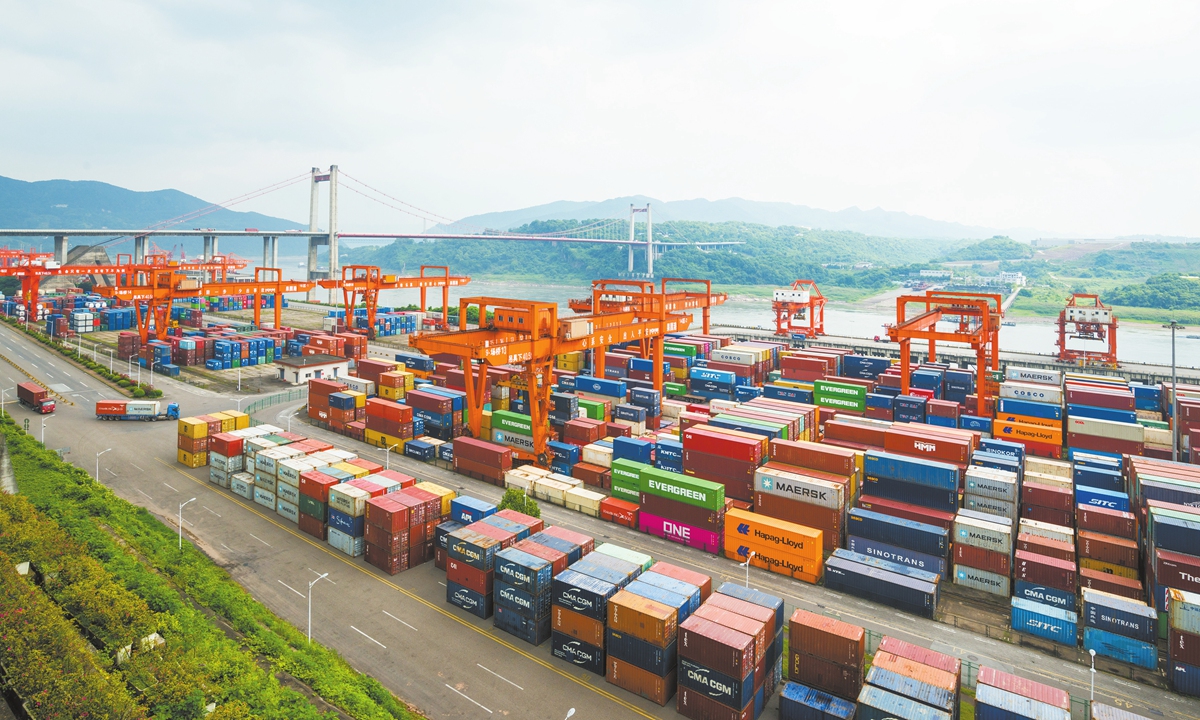
A view of the Guoyuan Port in Southwest China's Chongqing Municipality on May 19, 2024 Photo: Chen Tao/GT
Editor's Note: The recently released communique from the Third Plenary Session of the 20th Communist Party of China (CPC) Central Committee laid out an unequivocal commitment to comprehensively deepening reform to advance Chinese modernization. As China prepares to implement further reforms aimed at promoting high-quality economic development, the global community is scrutinizing every aspect of the Chinese economy. Zhong Ninghua, the head of the Department of Economics and Finance at Tongji University, provides insights on China's export growth in the face of global challenges.
Despite facing a number of external uncertainties, China's exports continue to grow, attracting much attention. Total exports have steadily expanded from 17.24 trillion yuan ($2.5 trillion) in 2019 to hit 23.77 trillion yuan in 2023.
Meanwhile, the past several years have also witnessed a noticeable trend of diversification in both export destinations and shipped products. From January to May 2024, China exported 1.39 trillion yuan of goods to the US, which grew by 3.6 percent year-on-year.
Due to sticky inflation in the US, affordable Chinese products have helped American households lower living costs and enhance their purchasing power, particularly benefiting the middle- and low-income groups there. These benefits have driven the overall rise in Chinese exports to the US.
From January to May 2024, China's exports to ASEAN countries totaled 1.67 trillion yuan, up 13.5 percent year-on-year, with notable increases to Laos, Vietnam, Cambodia, and Indonesia. And, China's exports to Central Asian nations and Arab countries have also witnessed marked growth.
Helped by the diversification bid in export destinations, the range of China's export shipments has broadened. Years ago, clothes, furniture, and home appliances dominated Chinese exports. In 2023, electric vehicles, lithium-ion batteries, and solar panels became the country's fastest-growing export items, totaling 1.06 trillion yuan in value, an increase of 29.9 percent year-on-year.
The rising exports of Chinese new-energy products will greatly support the global green transition.
Private and foreign-invested enterprises have played a premium role in China's exports. In 2023, the number of foreign trade dealers exceeded 600,000 for the first time, including 556,000 private enterprises. The establishment of 21,764 new foreign-invested enterprises in the first five months of this year marked a 17.4 percent year-on-year increase.
As China adjusts its export structure, many foreign firms are reshaping their investment strategies in the country. Production lines are shifting from mobile phones, computers, and home appliances to high-tech products, including new digital displays and high-end electric batteries. Notably, investments in scientific research and technological development by foreign firms continue to grow.
In the first five months this year, China's manufacturing sector attracted 117.1 billion yuan of foreign investment, with high-end manufacturing drawing 50.41 billion yuan. The progress echoes with China's robust industrial and supply chains, which cover a wide variety of emerging fields, typically the new-energy vehicles.
Against a complex global geopolitical background, Chinese companies are expanding investments across many regions in order to access larger international markets. In 2022, China's total outbound direct investment reached 985.37 billion yuan. In 2023, the investment exceeded 1 trillion yuan, marking a 5.7 percent year-on-year increase, with a focus on investing in markets like Southeast Asia, Africa, and Latin America.
The rising Chinese investments have helped drive local economic development and created many job opportunities.
Now, some Chinese companies are transforming into multinational corporations, deeply participating in the global supply chain, and integrating global resources such as raw materials and components. By bringing Chinese technology and innovations to other countries, Chinese companies are helping upgrade local industries.
Additionally, global warming is accelerating. Addressing the grave climate challenge calls for establishing an integrated trade system in the world, for such a system facilitates economic integration, benefits the disadvantaged populations, and helps promote green, low-carbon development.
The author is professor, head of Department of Economics and Finance, Tongji University. bizopinion@globaltimes.com.cn




